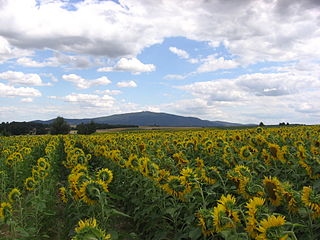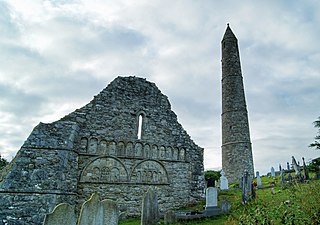
In Gaelic Ireland, between the 5th and 9th centuries AD, a dairthech [1] (literally "oak-house") was a type of oratory or church built of oak-wood. [2]

In Gaelic Ireland, between the 5th and 9th centuries AD, a dairthech [1] (literally "oak-house") was a type of oratory or church built of oak-wood. [2]
The dairthech was the earliest kind of church built in Ireland, from the earliest Christian times (5th century AD) onward. They were gradually replaced by stone churches.[ citation needed ]
A typical dairthech was rectangular, measuring 4.5 m (15 ft) by 3 m (9.8 ft). [2] Some were wider up to 4.5 m (15 ft), and congregations of 150–260 people are recorded. [3] It had a high pointed gable. [4] Oak was used as a building material as a holdover from Celtic religion, where the oak was imbued with magical powers. [5]
Little is known about the internal structure of the dairthech, although descriptions of the murder of Echtigern in Kildare in AD 760 offer a few hints, mentioning a chancel-screen (Old Irish: cróchaingel) and altar (altóir). Cogitosus describes painted partitions dividing clergy from laity and women from men. [6]

The Ślęża is a 718 m (2,356 ft) high mountain in the Sudeten Foreland in Poland. The mountain is built mostly of granite and is covered with forests.

Ullard Church is a medieval church and National Monument in County Kilkenny, Ireland.
Drumlohan souterrain and ogham stones, known locally as the Ogham Cave, is a souterrain with ogham stones forming a National Monument located in County Waterford, Ireland.

Altar Wedge Tomb is a wedge-shaped gallery grave and national monument located outside the village of Schull, in County Cork, Ireland.

The Island Wedge Tomb is a wedge-shaped gallery grave and National Monument located southeast of Mallow in County Cork, Ireland.

Killulta Church is a medieval church and a National Monument in County Limerick, Ireland.

Loher Cashel is a stone ringfort (cashel) and National Monument located on the Iveragh Peninsula, Ireland.
Leacanabuaile is a stone ringfort (cashel) and National Monument in County Kerry, Ireland. Leacanabuaile is immediately northwest of Cahergal, 3 km (1.9 mi) northwest of Cahirciveen.
St. Manchan's Oratory, also called An Teampall Geal is a medieval oratory and National Monument in County Kerry, Ireland.

Glanfahan is a townland on the Dingle Peninsula, Ireland, notable for its large collection of clocháns, which form a National Monument.

Roscam is a medieval ecclesiastical site and National Monument located in County Galway, Ireland.

Kilbennen or Kilbannon is a medieval ecclesiastical site and National Monument located in County Galway, Ireland.
Kiltiernan Church is a medieval church and National Monument in County Galway, Ireland.

Kilmalkedar is a medieval ecclesiastical site and National Monument located in County Kerry, Ireland.

Donaghcumper Church is a ruined medieval church in Celbridge, Ireland. On the Record of Monuments and Places it bears the code KD011-013.

Templesaghtmacree is an Early Christian church and National Monument located on Inishmaan, Ireland.

Dún Fearbhaí is a stone ringfort (cashel) and national monument located on Inishmaan, one of the Aran Islands, Ireland.

Dísert Óengusa is a medieval hermitage and National Monument located in County Limerick, Ireland.

High Street is a street in the medieval area of Dublin, Ireland.

St. Declan's Monastery, containing the remains of Ardmore Cathedral, is a former monastery and National Monument located in County Waterford, Ireland.